20:59 EDT FRIday, 19/04/2024
•Menu
•Top News
-
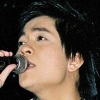 In Memory of Singer Nhật Sơn
In Memory of Singer Nhật Sơn
-
 Gia Bao revealed the reason behind Minh Canh’s invitation to participate in Vietnamese talent promotion
Gia Bao revealed the reason behind Minh Canh’s invitation to participate in Vietnamese talent promotion
-
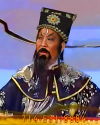 “First famous vocalist” Minh Canh 86 years old: How is your health and voice?
“First famous vocalist” Minh Canh 86 years old: How is your health and voice?
- Japanese artist: Why are Vietnamese people so kind and beautiful?
- 2023 Ca Mau Southern Folk Cake Festival opens
-
 Artist Minh Canh suddenly has a second live show
Artist Minh Canh suddenly has a second live show
-
 After Decades Under the Bed, a 1974 Vietnamese Film Finds an Audience Online
After Decades Under the Bed, a 1974 Vietnamese Film Finds an Audience Online
-
 Artist Kieu Phuong Loan is surprised to see her image 35 years ago
Artist Kieu Phuong Loan is surprised to see her image 35 years ago
- 5.000 Vietnamese studying in France: What's new in visa and scholarship policies in 2024?
-
 Doan Minh Tai looks like a gentleman, wearing a Mon Amie suit
Doan Minh Tai looks like a gentleman, wearing a Mon Amie suit
•Random News
•Counter
![]() Online :
18
Online :
18
![]() Today :
3433
Today :
3433
![]() This month
: 60345
This month
: 60345
![]() Total : 2604292
Total : 2604292
 »
News
»
Culture
»
News
»
Culture

Vietnam's banh mi named world's most delicious sandwich
ietnamese banh mi (baguette) has been ranked first in the list of the top 100 sandwiches in the world by international food website Taste Atlas.
VỌNG CỔ & TRADITIONAL MUSIC INSTRUMENTS
Posted at: TUEsday - 07/04/2015 18:02 - Viewed: 5052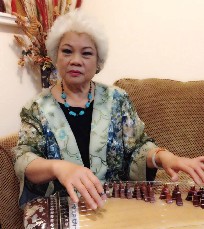
VỌNG CỔ & TRADITIONAL MUSIC INSTRUMENTS
1- Lục huyền cầm (six-stringed instrument) or ghi-ta phím lõm (guitar with pitted frets).
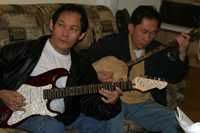
2- Đàn kìm or nguyệt cầm - moon lute
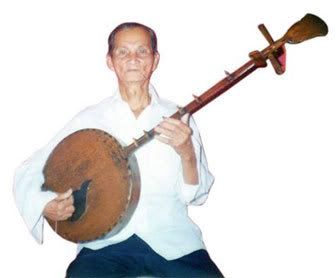
The name of the instrument comes from the Hán Việt (Sino-Vietnamese) word for moon, nguyệt, and thus it is often called a "moon lute" in English. It roughly resembles a banjo in appearance, with a round (and thus moonlike) body and a long fingerboard. Fixed to the fingerboard are tall frets over which run two strings. The instrument is held with the right hand plucking and the left hand along the fingerboard. It is used in genres throughout Vietnam, although some of the most prominent include nhạc tài tử and hát văn.
3- Đàn tỳ bà - pear-shaped lute

The đàn tỳ bà or pear-shaped lute is a four-string lute with a characteristic "pear" or "tear" shape, as the English name implies. The body and neck are seamlessly integrated, as opposed to other Vietnamese lutes with smaller or shorter bodies and longer necks. The four-strings have individual tuners, two jutting out of each side of the instrument head, which is often intricately carved. The instrument is either played vertically, sitting on the performer's lap, or in recent days, horizontally in similar fashion to a guitar. Đàn tỳ bà is most often seen in nhạc tài tử ensembles these days.
4- Đàn nhị or đàn cò - two-string fiddle
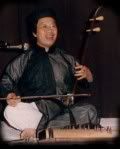
The Vietnamese đàn nhị or "two-string fiddle" bears a striking resemblence to similar instruments both in China and in the rest of Southeast Asia. Most accurately, the label refers to a whole class of instruments constructed with a slender shaft for a body, curved at one end and attached to a resonator box at the other. Two tuning pegs are attached at the curved end, and two strings run from the tuning pegs to the resonator box. A bow made of wood and horsehair is used to play the instrument, with the horsehair running between the two strings. The size and kind of resonator box determines the specific kind, including đàn hồ, đàn gáo, đàn cò cao/đàn cò lòn, etc..
5- Đàn tranh or thập lục huyền cầm, đàn thập lục - sixteen-string zither

The đàn tranh or "sixteen-string zither" is probably one of the most well-known of the traditional instruments, experiencing a recent resurgence especially among young Vietnamese girls. The instrument body is a long, hollowed wooden box tapered at one end. Sixteen strings, traditionally of silk, pass from the broad end towards the narrow end and are held there with individual pegs. A raised bridge for each string lies approximately at its middle. A player plucks the string with the right hand to the right of tbe bridge, while the left hand presses on the left side of the string to bend the string's pitch and provide ornamentation.
6- Đàn bầu or độc huyền cầm, đàn độc huyền - monochord

The đàn bầu is a single-stringed instrument that consists of a long wooden board with one string that runs the entire length of the instrument. The string on one end is run into the instrument to a tuning peg; on the other end, it is tied to a flexible rod coming out of the wooden body and into a soundbox made from a hollowed gourd. The player uses a plectrum in the right hand, plucking while the base of the pinky is rested on a harmonic node; the left hand pushes and pulls the rod to change the tension of the string, creating intermediate pitches and ornamentation.

2- Đàn kìm or nguyệt cầm - moon lute

The name of the instrument comes from the Hán Việt (Sino-Vietnamese) word for moon, nguyệt, and thus it is often called a "moon lute" in English. It roughly resembles a banjo in appearance, with a round (and thus moonlike) body and a long fingerboard. Fixed to the fingerboard are tall frets over which run two strings. The instrument is held with the right hand plucking and the left hand along the fingerboard. It is used in genres throughout Vietnam, although some of the most prominent include nhạc tài tử and hát văn.
3- Đàn tỳ bà - pear-shaped lute

The đàn tỳ bà or pear-shaped lute is a four-string lute with a characteristic "pear" or "tear" shape, as the English name implies. The body and neck are seamlessly integrated, as opposed to other Vietnamese lutes with smaller or shorter bodies and longer necks. The four-strings have individual tuners, two jutting out of each side of the instrument head, which is often intricately carved. The instrument is either played vertically, sitting on the performer's lap, or in recent days, horizontally in similar fashion to a guitar. Đàn tỳ bà is most often seen in nhạc tài tử ensembles these days.
4- Đàn nhị or đàn cò - two-string fiddle

The Vietnamese đàn nhị or "two-string fiddle" bears a striking resemblence to similar instruments both in China and in the rest of Southeast Asia. Most accurately, the label refers to a whole class of instruments constructed with a slender shaft for a body, curved at one end and attached to a resonator box at the other. Two tuning pegs are attached at the curved end, and two strings run from the tuning pegs to the resonator box. A bow made of wood and horsehair is used to play the instrument, with the horsehair running between the two strings. The size and kind of resonator box determines the specific kind, including đàn hồ, đàn gáo, đàn cò cao/đàn cò lòn, etc..
5- Đàn tranh or thập lục huyền cầm, đàn thập lục - sixteen-string zither

The đàn tranh or "sixteen-string zither" is probably one of the most well-known of the traditional instruments, experiencing a recent resurgence especially among young Vietnamese girls. The instrument body is a long, hollowed wooden box tapered at one end. Sixteen strings, traditionally of silk, pass from the broad end towards the narrow end and are held there with individual pegs. A raised bridge for each string lies approximately at its middle. A player plucks the string with the right hand to the right of tbe bridge, while the left hand presses on the left side of the string to bend the string's pitch and provide ornamentation.
6- Đàn bầu or độc huyền cầm, đàn độc huyền - monochord

The đàn bầu is a single-stringed instrument that consists of a long wooden board with one string that runs the entire length of the instrument. The string on one end is run into the instrument to a tuning peg; on the other end, it is tied to a flexible rod coming out of the wooden body and into a soundbox made from a hollowed gourd. The player uses a plectrum in the right hand, plucking while the base of the pinky is rested on a harmonic node; the left hand pushes and pulls the rod to change the tension of the string, creating intermediate pitches and ornamentation.
Source: tcgd theo Viet Music
Key:
vọng cổ, song or, more appropriately, cycle or, pattern performed, in cải, lương opera, renovated theater, although created, in the, twentieth century, it is, most similar, to and, has its, roots in, nhạc tài, tử chamber, music of, south việt, nam as, the central, foundation to, cải it, framework for, lyricism and, instrumentation while, being the, only piece
Newer articles
- THE SURVIVAL OF THE TRADITIONAL MUSIC (NHAC CO TRUYEN) (15/10/2015)
- 2016 Hue Festival introduces Vietnam's first temporary festival (17/12/2015)
- Nguyen Kings historical records displayed (03/01/2016)
- VIETNAMESE TRADITIONAL THEATRE (22/03/2016)
- City theaters to honor Vietnam stage day (03/10/2015)
- Queen of cai luong brought back to life on stage (19/08/2015)
- The magic of the Vong Co song (17/05/2015)
- National song and dance competition 2015 opens in Thai Nguyen (25/05/2015)
- Vietnamese film week in US kicks off (23/06/2015)
- Southern Folk Song Festival kicks off (12/05/2015)
Older articles
- Don Ca Tai Tu Nam Bo receives UNESCO Award (19/03/2015)
- Don Ca Tai Tu gets an unforgettable year (06/03/2015)
- Ethnomusicologist Tran Quang Hai helps honour Vietnamese music (01/03/2015)
•GO TO...
•Hot News
-
 Vietnam's banh mi named world's most delicious sandwich
Vietnam's banh mi named world's most delicious sandwich
-
 HCMC student accepted to 16 US universities
HCMC student accepted to 16 US universities
-
 Over 21,000 tourists visit Huong Pagoda on ticket sales' first day for festival
Over 21,000 tourists visit Huong Pagoda on ticket sales' first day for festival
-
 One more Vietnamese singer appears in Times Square in New York
One more Vietnamese singer appears in Times Square in New York
- Youth’s Tet festival to return to HCMC
-
 Annual Book Street Festival 2024 on Tet holiday to open on February 7
Annual Book Street Festival 2024 on Tet holiday to open on February 7
-
 Don Ca Tai Tu Nam Bo Festival 2023 opens in Bac Lieu
Don Ca Tai Tu Nam Bo Festival 2023 opens in Bac Lieu
-
 Who is the youngest female Cai Luong artist to be awarded People's Artist?
Who is the youngest female Cai Luong artist to be awarded People's Artist?
-
 Legendary cai luong singer Thanh Duoc passes away in US
Legendary cai luong singer Thanh Duoc passes away in US
-
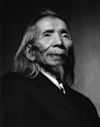 Concert to mark 100th birthday anniversary of great composer Van Cao
Concert to mark 100th birthday anniversary of great composer Van Cao
- Japanese artist: Why are Vietnamese people so kind and beautiful?
- 5.000 Vietnamese studying in France: What's new in visa and scholarship policies in 2024?
-
 Doan Minh Tai looks like a gentleman, wearing a Mon Amie suit
Doan Minh Tai looks like a gentleman, wearing a Mon Amie suit
-
 Artist Kieu Phuong Loan is surprised to see her image 35 years ago
Artist Kieu Phuong Loan is surprised to see her image 35 years ago
-
 In Memory of Singer Nhật Sơn
In Memory of Singer Nhật Sơn
-
 After Decades Under the Bed, a 1974 Vietnamese Film Finds an Audience Online
After Decades Under the Bed, a 1974 Vietnamese Film Finds an Audience Online
-
 Artist Minh Canh suddenly has a second live show
Artist Minh Canh suddenly has a second live show
-
 Gia Bao revealed the reason behind Minh Canh’s invitation to participate in Vietnamese talent promotion
Gia Bao revealed the reason behind Minh Canh’s invitation to participate in Vietnamese talent promotion
-
 “First famous vocalist” Minh Canh 86 years old: How is your health and voice?
“First famous vocalist” Minh Canh 86 years old: How is your health and voice?
- 2023 Ca Mau Southern Folk Cake Festival opens


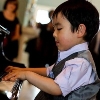
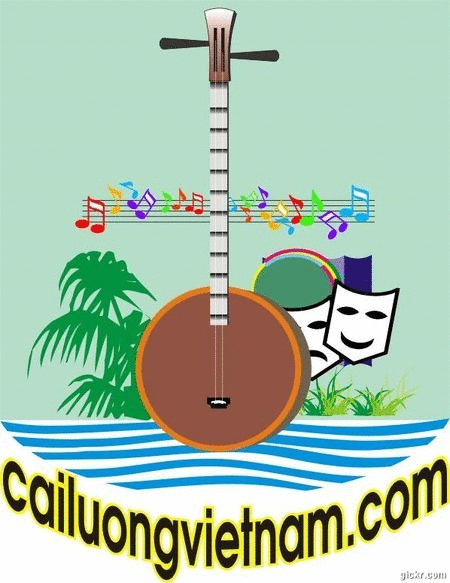






Reader Comments